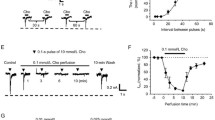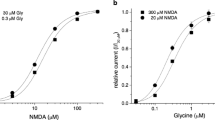Summary
The actions of Pb2+ on NMDA channel currents of acutely dissociated hippocampal CA1- and CA3-neurones from adult rats activated by aspartate plus glycine (asp/gly) were examined. A fast reversible and a slow irreversible response to Pb2+ were found. Pb2+ applied simultaneously with asp/gly decreased an inward current. The threshold concentration was below 2 μM, the current was reduced > 90% at concentrations over 100 μM, The decrease of the asp/gly activated current showed no voltage dependence. Opening of NMDA channels was not necessary for Pb2+-action, as preincubation in 50 μM Pb2+-containing external solution for several seconds dramatically reduced the response to asp/gly/Pb2+. This effect was reversed within 2 to 5 s of wash. Presence of Pb2+ or asp/Pb2+ or glycine/Pb2+ in the external solution did not prevent recovery of the NMDA receptor/channel complex from desensitization. Prolonged perfusion of a cell with the asp/gly/Pb2+-containing external solution resulted in an irreversible decrease of the asp/gly current, whereas the amplitude of the asp/gly/Pb2+ response did not change over the duration of an experiment. We conclude that Pb2+ modulates NMDA channel activity via interaction with the NMDA/glycine receptor: as a result the channel current decreases.
Similar content being viewed by others
Abbreviations
- NMDA:
-
N-methyl-D-aspartate
- LTP:
-
long-term potentiation
- AP5:
-
2-amino-5-phosphonovalerate
- EGTA:
-
ethylene glycol bis(-aminoethylether)-N,N,N′,N′-tetraacetic acid
- HEPES:
-
4-(2-hydroxyethyl)-1-piperazineethanesulfonic acid
References
Alkondon M, Costa ACS, Radhakrishnan V, Aronstam RS, Albuquerque EX (1990) Selective blockade of NMDA-activated channel currents may be implicated in learning deficits caused by lead. FEBS Lett 261:124–130
Altmann L, Sveinsson K, Wiegand H (1991) Long-term potentiation in rat hippocampal slices is impaired following acute lead perfusion. Neurosci Lett 128:109–112
Büsselberg D, Evans ML, Rahmann H, Carpenter DO (1991) Lead and zinc block a voltage-activated calcium channel of Aplysia neurons. J Neurophysiol 65:786–795
Chizhmakov IV, Kiskin NI, Krishtal OA, Tsyndrenko AY (1989) Glycine action on NMDA receptors in rat hippocampal neurons. Neurosci Lett 99:131–136
Damstra T (1977) Toxicological properties of lead. Environ Health Persp 19:297–307
Evans ML, Büsselberg D, Carpenter DO (1991) Pb blocks calcium currents of cultured dorsal root ganglion cells. Neurosci Lett 129:103–106
Hori N, Büsselberg D, Matthews R, Parsons P, Carpenter DO (1993) Lead blocks UP by an action not at NMDA receptors. J Exp Neurol (in press)
Johnson JW, Ascher P (1987) Glycine potentiates the NMDA response in cultured mouse brain neurons. Nature 338:425–427
Lasley SM, Armstrong DL, Polan-Curtin J (1991) In vivo induction of hippocampal long-term potentiation (LTP) in rats is impaired by chronic exposure to environmental levels of lead (Pb2+). Abstracts of Ninth International Neurotoxicology Conference, Little Rock, Arkansas, October 28–31
MacDermott AB, Mayer ML, Westbrook GL, Smith SJ, Barker JL (1986) NMDA-receptor activation increases cytoplasmic calcium concentration in cultured spinal cord neurons. Nature 321:519–522
Marcovac J, Goldstein GW (1988) Micromolar concentrations of lead stimulate brain protein kinase C. Nature 334:71–73
Mayer ML, Westbrook GL (1987) Permeation and block of N-methil-aspartic acid receptor channels by divalent cations in mouse cultured central neurons. J Physiol 394:501- 527
Mayer ML, Westbrook GL, Guthrie PG (1984) Voltage-dependent block of Mg2+ of NMDA responses in spinal cord neurons. Nature 309:261–263
McMichel AJ, Baghurst PA, Wigg NR, Vimpani GV, Robertson EF, Russell RJ (1988) Port Pirie cohort study: environmental exposure to lead and children's abilities at the age of four years. N Engl J Med 319:468–475
Needleman HL, Gunnoe C, Leviton A, Reed R, Peresie H, Maher C, Barrett P (1979) Deficits in psychologic and classroom performance of children with elevated dentine lead levels. N Engl J Med 300:689–695
Nowak L, Bregestovski P, Ascher P, Herbert A, Prochiantz A (1984) Magnesium gates L-glutamate-activated channels in mouse central neurons. Nature 307:462–465
Sather W, Dieudonne S, Macdonald J, Ascher P (1992) Activation and desensitization of N-methyl-D-aspartate receptors in nucleated outside-out patches from mouse neurons. J Physiol 450:643–672
Zilberter YI, Uteshev VV, Sokolova SN, Motin LG, Eremjan HH (1990) Potentiation of glutamate-activated currents in isolated hippocampal neurons. Neuron 5:597–602
Zilberter Y, Uteshev V, Sokolova S, Khodorov B (1991) Desensitization of NMDA receptors in neurons dissociated from adult rat hippocampus. Mol Pharmacol 40:337–341
Author information
Authors and Affiliations
Additional information
Correspondence to H. L. Haas at the above address
Rights and permissions
About this article
Cite this article
Uteshev, V., Büsselberg, D. & Haas, H.L. Pb2+ modulates the NMDA-receptor-channel complex. Naunyn-Schmiedeberg's Arch Pharmacol 347, 209–213 (1993). https://doi.org/10.1007/BF00169269
Received:
Accepted:
Issue Date:
DOI: https://doi.org/10.1007/BF00169269




